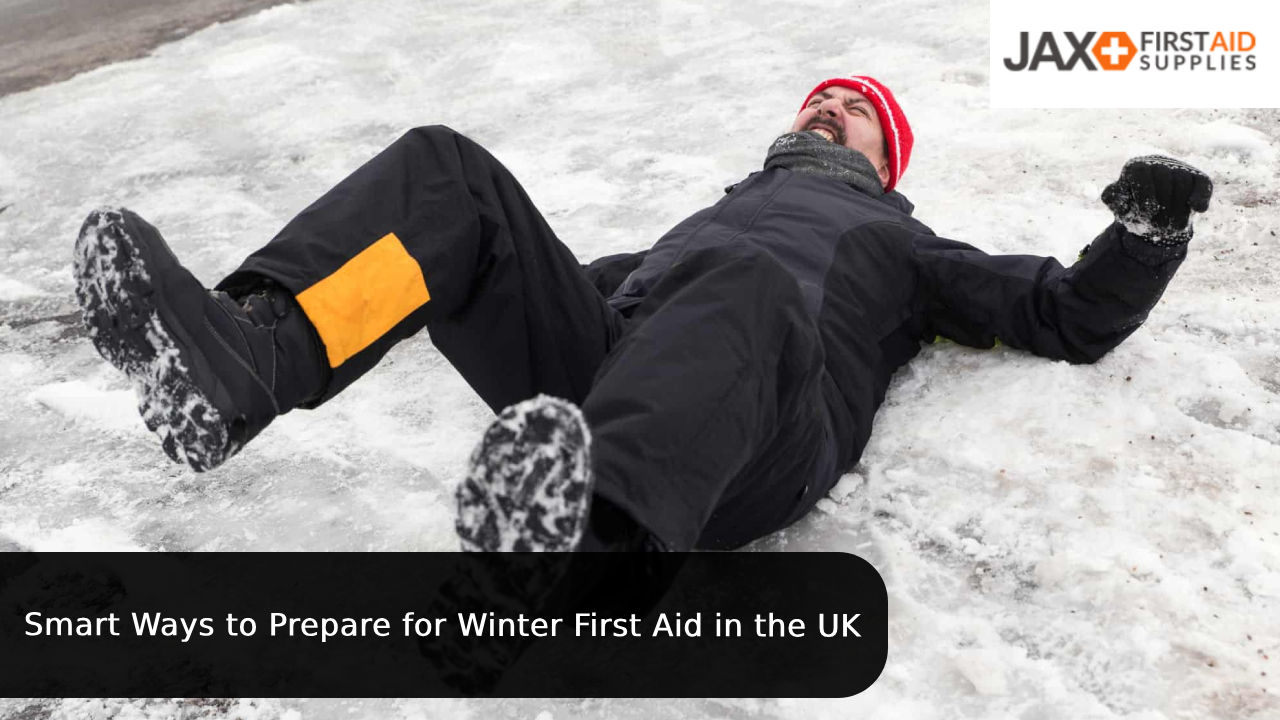Smart Ways to Prepare for Winter First Aid in the UK
Published by Jax First Aid Supplies on 22nd Oct 2025
Understanding the importance of winter first aid:
Unfortunately, with winter comes chilly mornings, icy pavements, and unpredictable weather that could get anyone by surprise. Frostbite, hypothermia, slips, and sprains are just some of the many unique challenges in the colder months. That's why preparing for winter first aid is not just smart, but essential for safety and wellbeing.
Why is cold weather a contributing factor to injury?
As temperatures start to fall, the human body has to work harder to stay warm. Reduced blood flow can increase the risk of cold related illnesses and injuries, whilst icy and wet surfaces make falls more likely. Additionally, shorter daylight hours give minimised visibility that increases the chances of road or workplace accidents.
What are the commonest winter emergencies in the UK?
The most common injuries during winter include the following:
- Icy paths can lead to slips trips and falls
- Frostbite and hypothermia after cold exposure
- Burns by cold while handling metals or frozen materials
- Mild cuts and bruises associated with winter activities, such as snow clearing
Being ready with the best first aid equipment makes sure that when these accidents do happen, you are prepared to act fast and correctly.
Tips and Essentials for First Aid in Winter Preparedness
Stocking up first aid kits for homes and workplaces
Before winter fully arrives, it can be beneficial to inspect your first aid kits to make sure everything is in date and fully stocked up. It could be helpful to consider keeping multiple first aid kits; one at home, one in the car, and one in the workplace for example.
Treating Common Winter Injuries: Slips, Trips, and Falls
Falls on ice are among the most common causes of injury during winter. Equip your first aid kit with cold packs, bandages, plasters, and kinesiology tape to treat bruises and sprains immediately.
Frostbite, Hypothermia, and Cold Burns Management
When exposed to extreme cold for extended periods, the skin can freeze quite quickly, especially fingers, toes, and ears. It is highly beneficial to stock thermal blankets, foil blankets, and hand warmers to be readily available. They are important for preventing body temperature loss before help arrives.
First Aid Training: The Key to Winter
Even with the best first aid supplies, knowing how to use them accurately and effectively is key. Encourage your employees to complete first aid training and refreshers during the winter season, as this can give them confidence in handling emergencies, both at work and outdoors.
PPE and Workwear: The range includes warm and safe work possibilities.
Why Warm Workwear is a Must During Cold Conditions
Cold conditions lose dexterity, slow reaction time, and will eventually result in fatigue or tiredness. Wearing proper PPE and insulated workwear will help to prevent cold stress and improve productivity in the workplace effectively.
Winter Work: Best PPE - Bomber Jackets and Thermal Layers
Winter-ready PPE starts with wearing durable and warm outerwear.
- Thermal fleeces (thermals) for layering in cold conditions.
- Winter softshell jackets for added warmth under hi-vis workwear.
- Waterproof bomber jackets for maximum insulation, weather resistance and visibility.
Gloves, Hats and Beanies
The hands and head lose heat the fastest, making them crucial to protect in cold conditions. We recommend thermal gloves for keeping hands warm as well as handling equipment safely. Beanies or insulated hats are also effective to stay warm on site. Additionally, a wind protecting snood face covering is an excellent option for strong cold winds in conjunction with other warm workwear.
Workplace Compliance: Keeping the Employee Safe and Equipped
Employers are required by law under UK health and safety to supply their employees with the appropriate PPE and keep safe conditions. Providing the right PPE for winter ensures that regulations are met while keeping your employees well.
Creating a Winter Emergency Preparedness Kit
What Every Car Should Have for the Winter
Every car and van should include:
- A first aid kit
- Hi-vis vest or jacket
- De-icer spray
- Ice scraper
- Torch with batteries
- Blanket or thermal wrap
This kit can prove to be a helpful tool during breakdowns or delays in below-freezing conditions.
Preparing Outside Workplaces for Ice and Snow Hazards
Employers should have a stock of grit or salt, non-slip mats where necessary, and clean walkways regularly. Line managers must ensure that all employees wear suitable PPE including gloves, jacket, and boots.
Commonly Asked Questions
Q1. What should I carry in a winter first aid kit?
A: The usual first aid equipment and supplies plus the addition of thermal blankets, cold packs, and burn dressings.
Q2. How do workplaces minimize accidents during winter?
A: Workplaces can give anti-slip footwear, clear icy surfaces, and proper lighting in dark or fog condition area and also can make the employee highly visible with a vest or jacket.
Q3. What is the most effective PPE wear in cold weather conditions?
A: Insulated bomber jackets, thermal gloves, and fleece beanies are among the best PPE items for cold weather.
Q4. How often must first-aid kits be examined in winter?
A: First aid kits should be checked every month for used or expired items that need to be replaced and items that have been used need to be replaced.
Q5. Is Jax First Aid PPE compliant with the UK safety standard?
A: All Jax First Aid PPE & Workwear meets or exceeds UK and EU safety requirements.
Q6. Can heat retaining clothes prevent hypothermia?
A: Layered, insulated PPE protects against hypothermia by keeping the body at a high temperature.
Be Prepared, Keep Safe, and Safeguard Your Team
Preparation is the best protection against the hazards from winter and cold, icy conditions, whether at home or on the road to the workplace, and using the right first aid supply stocked and best PPE worn keeps everyone safe, warm, and compliant.








